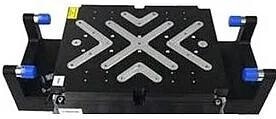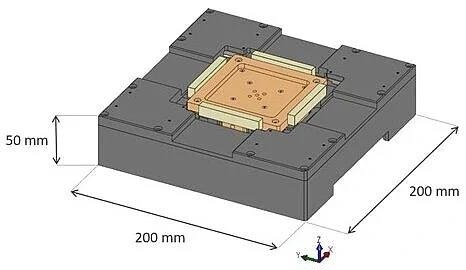Magnetic levitation, or maglev, represents a friction-free technology relying on magnetic fields to lift and move objects. Its rather well known uses span high-speed trains and magnetic bearings. A new application employs this technology to deliver significant advantages for nanopositioning and ultra-precise motion control.

Magnetic levitation nanopositioning technology demonstrator. Image Credit: PI (Physik Instrumente) LP
Magnetic Levitation Nanopositioning Stage w/6DOF Control | Technology Demonstrator.
Magnetic Levitation Nanopositioning Stage w/ 6DOF Control | Technology Demonstrator. Magnetic levitation nanopositioning stage with 6DOF control. Video Credit: PI (Physik Instrumente) LP
The core concept of magnetic levitation is the repulsion between similar magnetic poles. The basic setup involves two magnets: one placed in the object to be lifted and the other positioned below it.
The base magnets must be controllable coils for precision motion control, such as in linear stages. Managing lateral, vertical, pitch, yaw, and roll motions requires more than just a pair of magnets. Hallbach arrays are commonly used in practical applications to reduce energy use, boost load capacity, and reduce thermal energy release.
A position-sensing system is also required for motion controller feedback. Without mechanical bearings restricting the linear stage, a powerful, high-bandwidth multi-axis controller is necessary to manage other degrees of freedom.
Despite the complexity of magnetic levitation systems, the advantages are substantial. The absence of mechanical bearings grants significant freedom to rectify any bearing limitations electronically.
It also enables controlled small angular movements, useful for precise alignments in various applications without bulky additional stages. Moreover, programmed vertical motions are highly valuable for precise focusing.
PI researches magnetic levitation for nanopositioning and collaborates with customers to advance the technology. Interested parties can view a technology demonstration at PI's Silicon Valley tech center.
Advantages of Magnetic Levitation Nanopositioning Systems
- Active control over all six degrees of freedom for precise guidance
- Sensor and controls define guiding behavior, enabling additional positioning along the main X-axis
- Steady-state stability (jitter) is not influenced by stick-slip effects or airflow interference
- Frictionless guidance, devoid of rolling elements, lubrication, or airflow
- Elimination of stick-slip effects, maintenance, wear and tear, or abrasion from rolling elements
- No particle generation, ensuring the highest cleanliness, perfect for cleanroom applications
- The highest precision is possible, solely depending on sensors, drives, controls, and the control loop
- Potential compatibility with vacuum environments
- Absence of outgassing from lubricants, along with the encapsulation of critical materials
The compact technology demonstrator has the following specifications:
- X-axis linear travel range: 44 mm
- Y and Z-axis linear travel range: 0.5 mm
- Rotational range in Theta X, Y, Z: 5 mrad
- Maximum velocity in the X-axis: 400 mm/s
- Load capacity: up to 2 kg without increased power consumption
- Feasibility for upside-down operation
- Completely passive slider with no cable connections to the static base
- Dimensions: 200 x 160 x 45 mm
Going Angstrom: A Planar XY Stage Concept for MetExSPM – Metrological Express Scanning Probe Microscope

Planar MagLev XY Stage for the Metrological Express Scanning Probe Microscope. Image Credit: PI (Physik Instrumente) LP
PI is one of the partners in the MetExSPM project and EMPIR (European Metrology Research Programme) initiative.
PI will develop a planar magnetic levitation stage and hybrid piezo stages for an ultra-high-performance scanning probe microscope with better than one Angstrom resolution.
Preliminary specifications for the planar motion stage for sample positioning and scanning include:
- Position resolution: < 0.1 nm
- Position noise (1σ): < 0.3 nm
- Bandwidth (1µm amplitude): ≈ 100 Hz
- XY travel range: 12.7 x 12.7 mm
- Z travel range: ±0.25 mm
- Rotation range (pitch, roll, yaw): ±0.25°
- Motion velocity (XY plane): 10 mm/s
- Acceleration (XY plane): 1 m/s²
How Does a 6D MagLev Stage provide Nanometer Precision Motion? Magnetic Levitation | www.pi.ws
How Does a 6D MagLev Stage provide Nanometer Precision Motion? Magnetic Levitation | www.pi.ws. A granite-based planar XY-Maglev Stage with additional Z-motion and active pitch, yaw and roll angular motion for alignment or error compensation. Video Credit: PI (Physik Instrumente) LP

This information has been sourced, reviewed and adapted from materials provided by PI (Physik Instrumente) LP.
For more information on this source, please visit PI (Physik Instrumente) LP.